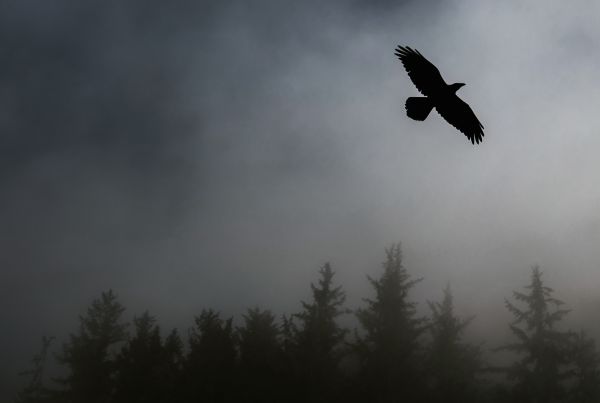Back in December of 2023, we were getting ready for the holidays, flooded with gratitude from the upswell of support for RAVEN that year. Then, out of nowhere, a big gift came from the Federal Court of Appeal.
The group of Wet’suwet’en Chiefs successfully appealed a Motion to Strike from Canada over their climate litigation, Misdzi Yikh v Canada. Although several parts of their original claim were struck, the decision allowed them to move their claim forward under section 7 of the Canadian Charter of Rights and Freedoms (Charter), which protects the right to life, liberty, and security of the person. We celebrated this wonderful news with sincere joy over the holiday break.
There’s also a twist in this story that’s not part of RAVEN-supported court cases. With the two Wet’suwet’en House groups of the Likhts’amisyu Clan being able to bring their case forward, so are 15 youth litigating for climate justice. La Rose v. His Majesty the King (La Rose) had the same issues as the Wet’suwet’en group’s case, so the Federal Court of Appeal heard and decided both at the same time, which will happen in certain instances at the appellate level. The youth, like the group of Wet’suwet’en Chiefs, are moving forward with their case under section 7 of the Charter.
We’ve been keeping you up to date about the group of Chiefs’ case as they have to go back to court yet again over a Motion to Strike the claim by Canada. But what happened with La Rose? Let’s get into this youth-led climate litigation to unpack its significance and where it’s at in the legal system now.
History
Fifteen youth from seven provinces and one territory filed a statement of claim in 2019 (“the Plaintiffs”). The Plaintiffs, who were ages 10 to 19 at the time of filing, argued that Canada’s high amounts of greenhouse gas emissions were incompatible with maintaining a stable climate. The serious harms of climate change are going to disproportionately affect the Plaintiffs because their future is going to be climate insecure if Canada doesn’t reduce its emissions. The Plaintiffs argued that, unless Canada drastically reduces greenhouse gas emissions, it will be in violation of the Charter under sections 7 and 15, as well as peace, order, and good government (POGG) in the Constitution Act, 1867, and a public trust doctrine.
At first, Canada’s Motion to Strike La Rose was successful. The Federal Court deemed the case to have an unreasonable cause of action and was non-justiciable under the Charter. The youth appealed the case, and since the issues were similar to the Wet’suwet’en Chiefs’ case, they were heard together at the Federal Court of Appeal.
Just like the Wet’suwet’en group’s case, La Rose had most of their claims struck in court, but were able to move forward with their claim under section 7 of the Charter. They amended their statement of claim and filed it in May 2024, continuing the process of this historic youth-led climate case.
Tollefson Law, one of the firms that’s representing the youth in La Rose, highlighted Plaintiff Kira Young’s perspective at the time of the filing:
“Alongside youth across the North, I have witnessed and experienced the forefront of climate change that poses a monumental threat to humanity… my generation and those to come are entitled to a planet that can sustain livelihoods, but also an environment that is conducive to harmony, peace, and integrity. Our leaders must be held accountable for the systemic violation of the rights of youth that is occurring today, because there is still time to secure a livable future.”
Where is La Rose now?
The youth filed their amended statement of claim in May 2024, but Canada was evidently not too impressed with the youth’s position. At the beginning of October that same year, they stated in a case management conference that they were going to file a Motion to Strike the amended statement of claim, similar to the group of Chiefs’ case. They filed their Motion to Strike a couple of months later.
The youth didn’t want to get tied up in another Motion to Strike. Instead, the youth agreed to alter their amended statement of claim to make the issues narrower, resulting in Canada dropping their Motion to Strike. In December 2024, Canada abandoned their Motion to Strike, and the youth filed another statement of claim in January 2025 with a statement of defence from Canada shortly after.
Avoiding a Motion to Strike allows the case to go to an eight-week trial in Vancouver for October 2026. Both parties are currently in discovery, which is essentially document compilation and research in support of the case, as well as oral interviews with Plaintiffs. Expert reports will also be important in this case, as the case relates to climate change. Examinations for discovery need to be complete by mid-January 2026 in order to properly prepare for trial.
Conclusion
It can be incredibly disheartening and frustrating to see the legal system moving so slowly in the face of climate catastrophe. However, as youth and Indigenous leaders continue to push on with climate litigation to keep governments accountable to reducing emissions, there is sincere hope for climate justice.
Plaintiff Sadie Ava Vipond said this in 2024, and it still rings true today: “I have been part of La Rose vs. His Majesty the King for 5 years now. It feels like a long time – and it is; with the ever-increasing wildfires and other climate change events becoming worse every year, more and more change must be made, and faster. I have hope in this case, hope it can contribute to protecting the future of the youth of Canada, hope that it can hold our government accountable, hope that it may help limit these wildfires for future generations.”
We’re going to keep an eye on this legal case as it moves through the courts. This litigation is being supported in partnership by Our Children’s Trust, the David Suzuki Foundation, and the Pacific Centre for Environmental Law and Litigation (CELL). We recommend you check out their websites to learn more about their work.






